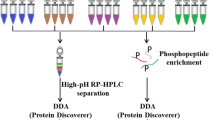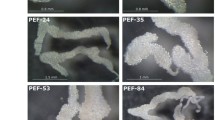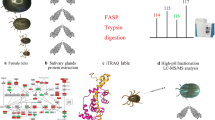Abstract
Ticks are obligate blood-sucking parasitic arthropods. When sucking the blood of hosts, they can also transmit a variety of pathogens to hosts that severely endanger the health of humans and animals. The spermatheca is an organ for the storage and protection of sperm and an important component of the reproductive system of female ticks. The spermatheca content changes dramatically over time after copulation. In particular, some proteins and polypeptide substances can influence the physiological functions of female ticks and promote blood feeding and egg laying by female ticks. To investigate the molecular mechanisms underlying the productive process of Haemaphysalis longicornis, data-independent acquisition (DIA) quantitative proteomics technology was used to perform in-depth research of the dynamic changes in all proteins in the spermatheca of ticks within a short time after copulation to look for key proteins in the spermatheca contents after copulation that affect the reproduction of female ticks in order to provide meaningful information for the comprehensive prevention and control of ticks.




Similar content being viewed by others
References
Al-Lawati H, Kamp G, Bienefeld K (2009) Characteristics of the spermathecal contents of old and young honeybee queens. J Insect Physiol 55:116–121
Alvarez JG, Storey BT (1989) Role of glutathione peroxidase in protecting mammalian spermatozoa from loss of motility caused by spontaneous lipid peroxidation. Gamete Res 23:77–90
Anisuzzaman IMK, Alim MA, Miyoshi T, Hatta T, Yamaji K, Matsumoto Y, Fujisaki K, Tsuji N (2012) Longistatin is an unconventional serine protease and induces protective immunity against tick infestation. Mol Biochem Parasitol 182:45–53
Baker MA, Aitken RJ (2004) The importance of redox regulated pathways in sperm cell biology. Mol Cell Endocrinol 216:47–54
Balashov YS (1972) Bloodsucking ticks (ixodoidea)-vectors of diseases of man and animals. Transl Misc Publ Entomol Soc America 8:159–376
Bauche F, Fouchard MH, Jegou B (1994) Antioxidant system in rat testicular cells. FEBS Lett 349:392–396
Black WC, Piesman J (1994) Phylogeny of hard- and soft-tick taxa (acari: Ixodida) based on mitochondrial 16s rdna sequences. Proc Natl Acad Sci USA 91:10034–10038
Carvalho GB, Kapahi P, Anderson DJ, Benzer S (2006) Allocrine modulation of feeding behavior by the sex peptide of Drosophila. Curr Biol 16:692–696
Collins AM, Williams V, Evans JD (2004) Sperm storage and antioxidative enzyme expression in the honey bee, Apis mellifera. Insect Mol Biol 13:141–146
den Boer SP, Boomsma JJ, Baer B (2009) Honey bee males and queens use glandular secretions to enhance sperm viability before and after storage. J Insect Physiol 55:538–543
Donohue KV, Khalil SM, Ross E, Mitchell RD, Roe RM, Sonenshine DE (2009) Male engorgement factor: role in stimulating engorgement to repletion in the ixodid tick, Dermacentor variabilis. J Insect Physiol 55:909–918
Dottorini T, Nicolaides L, Ranson H, Rogers DW, Crisanti A, Catteruccia F (2007) A genome-wide analysis in Anopheles gambiae mosquitoes reveals 46 male accessory gland genes, possible modulators of female behavior. Proc Natl Acad Sci USA 104:16215–16220
Filomeni G, Rotilio G, Ciriolo MR (2002) Cell signalling and the glutathione redox system. Biochem Pharmacol 64:1057–1064
Galantino-Homer HL, Florman HM, Storey BT, Dobrinski I, Kopf GS (2004) Bovine sperm capacitation: assessment of phosphodiesterase activity and intracellular alkalinization on capacitation-associated protein tyrosine phosphorylation. Mol Reprod Dev 67:487–500
Garayoa M, Villaro AC, Klein U, Zimmermann B, Montuenga LM, Sesma P (1995) Immunocytochemical localization of a vacuolar-type atpase in malpighian tubules of the ant Formica polyctena. Cell Tissue Res 282:343–350
Gessner B, Gessner K (1976) Inorganic ions in spermathecal fluid and their transport across the spermathecal membrane of the queen bee, Apis mellifera. J Insect Physiol 22
Gotoh A, Billen J, Hashim R, Ito F (2008) Comparison of spermatheca morphology between reproductive and non-reproductive females in social wasps. Arthropod Struct Dev 37:199–209
Gwynne DT (2008) Sexual conflict over nuptial gifts in insects. Annu Rev Entomol 53:83–101
Heifetz Y, Lung O, Frongillo EA Jr, Wolfner MF (2000) The Drosophila seminal fluid protein acp26aa stimulates release of oocytes by the ovary. Curr Biol 10:99–102
Iida K, Cavener DR (2004) Glucose dehydrogenase is required for normal sperm storage and utilization in female Drosophila melanogaster. J Exp Biol 207:675–681
Jones AR, Connor DE (2000) Fructose metabolism by mature boar spermatozoa. Reprod Fertil Dev 12:355–359
Jongejan F, Uilenberg G (2004) The global importance of ticks. Parasitology 129(Suppl):S3-14
Kang JG, Ko S, Smith WB, Kim HC, Lee IY, Chae JS (2016) Prevalence of anaplasma, bartonella and borrelia species in Haemaphysalis longicornis collected from goats in north korea. J Vet Sci 17:207–216
Kanost MR, Jiang H (2015) Clip-domain serine proteases as immune factors in insect hemolymph. Curr Opin Insect Sci 11:47–55
King M, Eubel H, Millar AH, Baer B (2011) Proteins within the seminal fluid are crucial to keep sperm viable in the honeybee Apis mellifera. J Insect Physiol 57:409–414
Klompen JS, Black WC, Keirans JE, Oliver JH Jr (1996) Evolution of ticks. Annu Rev Entomol 41:141–161
Laflamme BA, Wolfner MF (2013) Identification and function of proteolysis regulators in seminal fluid. Mol Reprod Dev 80:80–101
Lensky Y, Schindler H (1967) Motility and reversible inactivation of honeybee spermatozoa in vivo and in vitro. Ann Abeille 10:5–16
Marshall JL, Huestis DL, Hiromasa Y, Wheeler S, Oppert C, Marshall SA, Tomich JM, Oppert B (2009) Identification, rnai knockdown, and functional analysis of an ejaculate protein that mediates a postmating, prezygotic phenotype in a cricket. PLoS ONE 4:e7537
Ma J, Chen T, Wu S, Yang C, Bai M, Shu K, Li K, Zhang G, Jin Z, He F, Hermjakob H, Zhu Y (2019) iProX: an integrated proteome resource. Nucleic Acids Res 47(D1):D1211–D1217
Mbogo SK (1994) Immunisation of rabbits against the brown ear tick, Rhipicephalus appendiculatus using tick haemolymph. Exp Appl Acarol 18:281–291
O"Donnell, Mike, (2017) The v-atpase in insect epithelia. J Exp Biol 220:3201–3203
Okech BA, Boudko DY, Linser PJ, Harvey WR (2008) Cationic pathway of ph regulation in larvae of Anopheles gambiae. J Exp Biol 211:957–968
Paolicchi A, Dominici S, Pieri L, Maellaro E, Pompella A (2002) Glutathione catabolism as a signaling mechanism. Biochem Pharmacol 64:1027–1035
Rodriguez-Gil JE, Bonet S (2016) Current knowledge on boar sperm metabolism: comparison with other mammalian species. Theriogenology 85:4–11
Rosenberg R, Lindsey NP, Fischer M, Gregory CJ, Hinckley AF, Mead PS, Paz-Bailey G, Waterman SH, Drexler NA, Kersh GJ, Hooks H, Partridge SK, Visser SN, Beard CB, Petersen LR (2018) Vital signs: trends in reported vectorborne disease cases—united states and territories, 2004–2016. MMWR Morb Mortal Wkly Rep 67:496–501
Saleh RA, Agarwal A (2002) Oxidative stress and male infertility: from research bench to clinical practice. J Androl 23:737–752
Satyavathi VV, Minz A, Nagaraju J (2014) Nodulation: an unexplored cellular defense mechanism in insects. Cell Signal 26:1753–1763
Seligman J, Newton GL, Fahey RC, Shalgi R, Kosower NS (2005) Nonprotein thiols and disulfides in rat epididymal spermatozoa and epididymal fluid: role of gamma-glutamyl-transpeptidase in sperm maturation. J Androl 26:629–637
Soller M, Bownes M, Kubli E (1999) Control of oocyte maturation in sexually mature Drosophila females. Dev Biol 208:337–351
Sonenshine DE, Roe RM (2013) Ticks, people and animals. Biol Ticks 1:2
Sonenshine DE, Bissinger BW, Egekwu N, Donohue KV, Khalil SM, Roe RM, Munderloh UG (2011) First transcriptome of the testis-vas deferens-male accessory gland and proteome of the spermatophore from dermacentor variabilis (Acari: Ixodidae). PLoS ONE 6(9):
Tang H, Kambris Z, Lemaitre B, Hashimoto C (2008) A serpin that regulates immune melanization in the respiratory system of Drosophila. Dev Cell 15:617–626
Tate SS, Meister A (1985) Gamma-glutamyl transpeptidase from kidney. Methods Enzymol 113:400–419
Taylor ML, Wigmore C, Hodgson DJ, Wedell N, Hosken DJ (2008) Multiple mating increases female fitness in Drosophila simulans. Anim Behav 76:963–970
Tram U, Wolfner MF (1999) Male seminal fluid proteins are essential for sperm storage in Drosophila melanogaster. Genetics 153:837–844
Wang MJ, Hu YH, Li MX, Xu QQ, Zhang XL, Wang XS, Xue XM, Xiao Q, Liu JZ, Wang H (2020) A proteomics analysis of the ovarian development in females of Haemaphysalis longicornis. Exp Appl Acarol 80:289–309
Weiss BL, Kaufman WR (2004) Two feeding-induced proteins from the male gonad trigger engorgement of the female tick Amblyomma hebraeum. Proc Natl Acad Sci USA 101:5874–5879
Werner M, Simmons LW (2008) Insect sperm motility. Biol Rev Camb Philos Soc 83:191–208
Whitfield JB (2001) Gamma glutamyl transferase. Crit Rev Clin Lab Sci 38:263–355
Wolfner MF (2011) Precious essences: female secretions promote sperm storage in Drosophila. PLoS Biol 9:1001191
Acknowledgements
This work was supported by the Natural Science Foundation for Excellent Youth Scholars of Hebei Province of China (No. C2017205135), the Natural Science Fund for Distinguished Young Scholars of Hebei Normal University (No. L2017J04), and the Open Funds of the State Key Laboratory of Veterinary Etiological Biology, Lanzhou Veterinary Research Institute, Chinese Academy of Agricultural Sciences (No. SKLVEB2018KFKT007).
Author information
Authors and Affiliations
Contributions
HW designed experiments and wrote the initial manuscript. SZ, XW, YH, YH performed experiments. XX, ML prepared figures. JL designed experiments and corrected the manuscript.
Corresponding authors
Ethics declarations
Conflict of interest
The authors declare that they have no conflict of interest.
Ethical approval
This study was approved by the Animal Ethics Committee of Hebei Normal University (No. 165031) as complying with the animal protection law of the People’s Republic of China.
Additional information
Publisher's Note
Springer Nature remains neutral with regard to jurisdictional claims in published maps and institutional affiliations.
Rights and permissions
About this article
Cite this article
Wang, X., Hu, Y., Han, Y. et al. Comprehensive dynamic analysis of proteins in the spermatheca of female Haemaphysalis longicornis after copulation. Exp Appl Acarol 83, 583–596 (2021). https://doi.org/10.1007/s10493-021-00606-6
Received:
Accepted:
Published:
Issue Date:
DOI: https://doi.org/10.1007/s10493-021-00606-6




